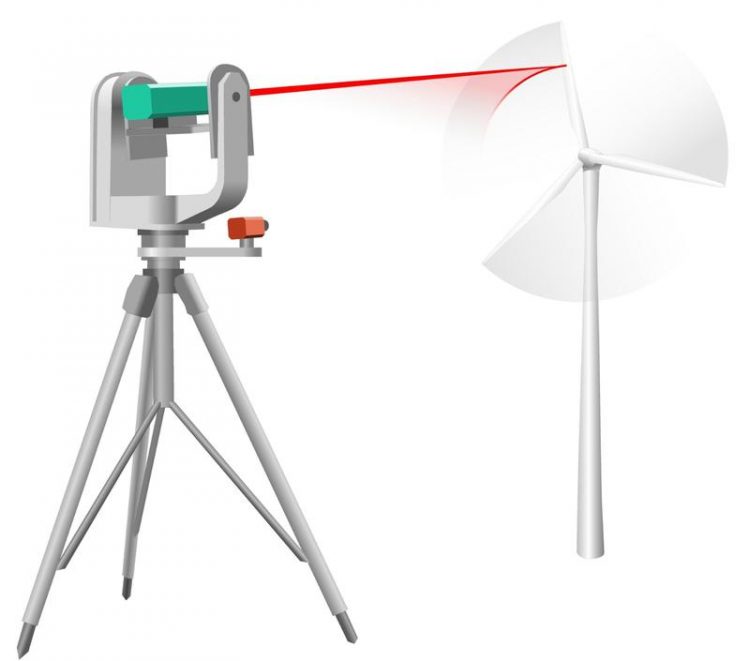CeBIT: VibroTrack – Measuring wind turbines from a distance

VibroTrack - Measuring wind turbines from a distance
The rotor and tower of a wind turbine can vibrate excessively even in normal operation. The analysis of these vibrations plays an important role in development and maintenance. Previously this was possible only selectively and directly on the installation. The Fraunhofer Institute of Optronics, System Technologies and Image Exploitation IOSB uses modern information technology to measure the vibration pattern of the entire system structure from a distance of several hundred meters.
The scientists will present the system concept at CeBIT at the Fraunhofer stand in Hall 9.
Even at normal wind speeds wind turbines oscillate by up to one meter. This places considerable strain on the material, which can cause damage and – in the worst case – system failure. Operators are therefore continually examining the magnitude of these vibrations with the help of sensors installed in the tower and rotor blades. The downside of this approach is that measurements can be taken only at those points at which sensors have been fitted. A complete pattern of vibrations for the entire installation cannot be obtained with this method. Offshore installations have additional requirements.
Researchers at the Fraunhofer IOSB have tackled this problem. At CeBIT in Hanover, they will present a system with which comprehensive vibration analyses of the entire installation can be performed from a distance of several hundred meters. The system contains a laser that is directed at the installation and is used to measure vibrations at any point of the wind turbine’s surface. To measure the vibration in moving parts, such as the rotor blades, the laser automatically follows their movement.
The tracking process is the key
This is achieved with the heart of the system – an IT-based tracking system, which is linked with the laser and image analysis system. Camera and laser are mounted on a pan-tilt head, allowing them to follow any point on a rotating rotor blade. The camera captures images of the installation and transmits them to image processing software, which uses them to generate a virtual model of the blades. Using these data, the tracking system controls the pan-tilt head to keep the laser focused on the rotor blades. At the same time the camera collects information about the exact position of the laser point on the rotor blade, which has a diameter of about two to three centimeters, to stabilize its orientation on the rotating wings.
By this method any number of points on the running installation can be scanned, even from a distance. The resulting analyses are quickly obtained and more comprehensive than with permanently installed sensors. The measurement duration is variable: The slower the vibrations, the longer the laser takes to measure them.
The compact system is mobile and can be taken to the desired location with a vehicle. Because of its high range it can also be used to study offshore installations from a ship, provided the ship’s own motion is compensated. Many wind farms in Germany have been in operation for more than 20 years, which is often their maximum lifespan. Operators can use this technology to evaluate their installations. The system provides decision-making support on issues such as: Does the condition of the installation allow its continued use? Do I sell it or do I build a new one on the same site?
At CeBIT, the researchers will present a prototype of the diagnostic tool. On a two-meter diameter model wind turbine at the joint Fraunhofer stand (Hall 9, Stand E40), visitors can follow the path of the eye-safe laser beam as a green dot on the rotor blades. On two connected screens the images from the camera and the vibration analysis can be seen.
The scientists will present the system at CeBIT at the Fraunhofer stand in Hall 9.
Weitere Informationen:
Media Contact
All latest news from the category: Trade Fair News
Newest articles

Bringing bio-inspired robots to life
Nebraska researcher Eric Markvicka gets NSF CAREER Award to pursue manufacture of novel materials for soft robotics and stretchable electronics. Engineers are increasingly eager to develop robots that mimic the…

Bella moths use poison to attract mates
Scientists are closer to finding out how. Pyrrolizidine alkaloids are as bitter and toxic as they are hard to pronounce. They’re produced by several different types of plants and are…

AI tool creates ‘synthetic’ images of cells
…for enhanced microscopy analysis. Observing individual cells through microscopes can reveal a range of important cell biological phenomena that frequently play a role in human diseases, but the process of…





















